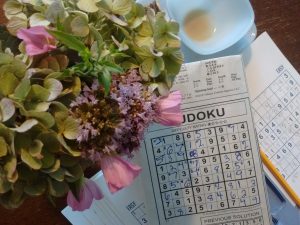
Confession time: I’m an addict. Every morning, I have to scratch my mental itch. My coffee doesn’t taste right and I don’t feel properly awake until I’ve worked through the Sudoku in the newspaper. My family knows, and fortunately they’re supportive. My Mother’s Day gift was a book of Sudoku puzzles with a handy slot to keep my pencil in!
Now, a year ago I wouldn’t touch one with a 10-foot pole. I’m perfectly competent at arithmetic. I multiply and divide fractions in my head when I’m sewing or baking. I even got a “B” in AP calculus, back in the day. But I’ve always felt that numbers were something you do because you need the result. Not something you play with for fun.
But a few months ago, I’d blitzed through the morning crossword and just felt…antsy. My ADHD brain needs a good hit of dopamine in the morning, and the crossword didn’t quite feel like an accomplishment. My little girl said, “There’s a Sudoku on the bottom of the page. We do them in school, they’re fun.”
I gave her some serious side-eye. 
But then, as she explained the concept to me, it gradually dawned on me. This is not a
“number” puzzle. You don’t add, subtract, or multiply the digits. You aren’t trying to compute any kind of mathematical result.
This is a logic puzzle. Each row, column, and square must contain every number. Every number can only appear once in each column, each row, and each square. You don’t have to use numbers. They could be any type of symbol, as long as there are nine distinct options. Numbers are just easy to recognize.
Working out the puzzle is governed by two basic rules: there are numbers that can only go in a certain position. And there are positions in which only one number can go.
I started enjoying the game after my crossword. Then I started preferring it to the crossword. Now I’m completely hooked.
You see, Sudoku puzzles are hypnotic for the same reason the best classic mysteries are hypnotic. Classic Sudoku have three groups of three rows and columns, and nine digits. Those digits could represent anything: Numbers. Colors. Emojis. Flowers.
Characters.
Nine is a magic number in mysteries, because it’s the upper limit of how many items you can hold in your conscious mind at once. Researchers analyzed Agatha Christie’s books and theorized that her normal pattern of following more than nine characters, with more than nine intersecting plotlines, helped create the immersive and hypnotic power of her books. The scientific claims of the researchers about the books’ effect on your brain chemistry have been debunked, but the experience is real and the mechanism of constructing a captivating plot remains.
Means, motive and opportunity. Nine moving parts. Pure logic.
Solve.